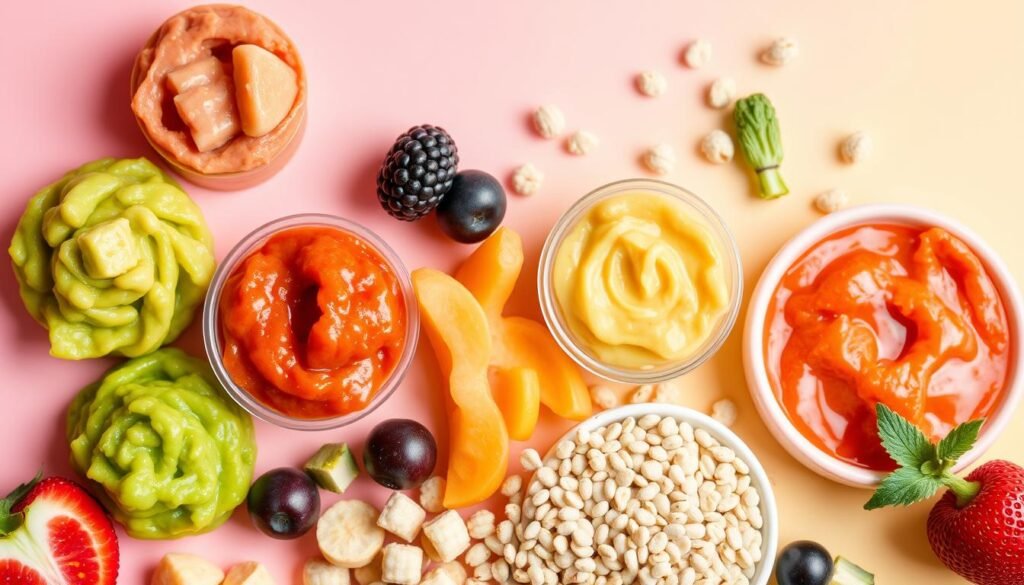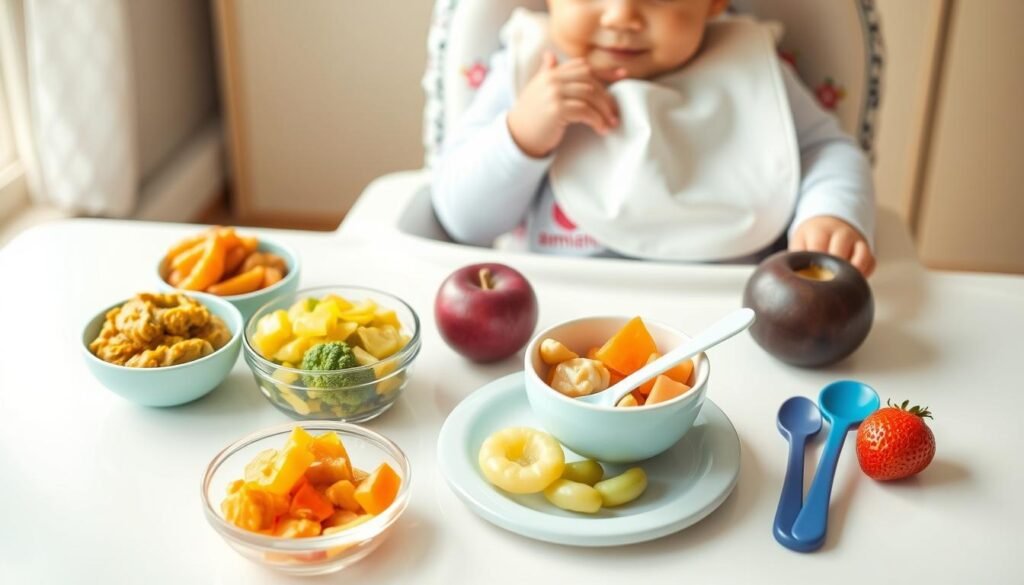When your baby hits 7-8 months, their eating habits start to change. They need a mix of breast milk or formula and solid foods. Babies usually drink 28 to 34 ounces of milk or formula each day1. They might eat every 3 to 4 hours, but this can change with solid foods1.
At this age, babies have 1 to 2 solid meals a day, besides their milk or formula1. These meals should include protein, carbs, fruits, and veggies. Each food group should be about 1 to 3 tablespoons2. It’s key to introduce many flavors and textures to help them explore different tastes1.
Some 7-8 month olds might need night feeds for better sleep. A dream feed or an early morning feed is suggested between 3:00 – 5:00 AM1. If they eat enough during the day, dropping night feeds can help them sleep better1.
Knowing your 7-8 month old’s eating needs helps you plan their meals. Remember, every baby is different. Pay attention to their signs and adjust their schedule as needed13.,
Understanding Your Baby’s Nutritional Needs at 7-8 Months
When your baby hits 7-8 months, their diet needs change. They need the right mix of breast milk or formula and solid foods. This is key for their growth.
Daily Nutritional Requirements
Babies at 7-8 months usually weigh 16 to 23 pounds. They need about 750-900 calories a day4. Most of these calories, 400-500, should come from breast milk or formula4.
Breast Milk and Formula Intake Guidelines
An 8-month-old baby might drink 24 ounces of breast milk or formula daily. This is usually in four 6-ounce bottles4. It helps them get the nutrients and calories they need5.
Transitioning to Solid Foods
The American Academy of Pediatrics says to start solid foods at 8 to 12 months4. An 8-month-old’s meal might include 2-4 oz of fruits or veggies, 2-4 oz of yogurt or cottage cheese, and 2-4 oz of meat or tofu. They also need 4-6 oz of breast milk or formula4. As they grow, you can increase the food amounts and introduce new foods5.
Remember, breast milk or formula is still the main food for your 7-8 month old. Try different textures and flavors, giving 1-3 tablespoons of each food group per meal4. This helps them develop a varied taste and get all the nutrients they need.
Basic Daily Feeding Schedule for 7-8 Month Olds
Creating a regular feeding schedule is key for your 7-8 month old baby. Babies at this age usually follow a 4-feed/4-hour or a 5-feed/3-3.5 hour schedule6. It’s important to watch for your baby’s hunger cues and adjust the times to meet their nutritional needs.
Here’s a sample daily feeding schedule to guide you:
- Wake-up (7:00 AM): Breast milk or formula
- Breakfast (8:00 AM): Solid meal
- Mid-morning (10:30 AM): Breast milk or formula
- Lunch (11:30 AM): Solid meal
- Mid-afternoon (2:30 PM): Breast milk or formula
- Dinner (5:30 PM): Breast milk or formula
- Bedtime (7:30 PM): Breast milk or formula
These are just guidelines. You might need to tweak the times based on your baby’s needs and your family’s schedule6. The goal is to find a routine that fits your baby and your household.
At 8 months, babies usually have 6 to 8 milk feeds in 24 hours and take two naps7. Breastfed babies around seven months need about 20oz (600mls) of milk daily8. They might breastfeed before, between, after meals, and sometimes at night8.
Introducing solid foods should be slow and gradual. Babies at this age are learning to eat and should try different foods7. By seven months, they should have three meals a day, but they might not eat everything, and some days they might not want to eat at all8.
It’s important to offer structure and predictability to make your baby feel secure and reduce anxiety6. With patience and consistency, you can find a feeding routine that suits your family.
Creating the Perfect Mealtime Environment
As your 7-8 month old baby starts eating solid foods, a safe and comfy meal area is key9. By now, most babies eat three times a day, with milk or formula still important9. Let’s look at how to set up the best spot for feeding.
Setting Up a Feeding Space
Find a spot near the family table for a sturdy, stable highchair9. This lets your baby join meals and watch your family eat9. Make sure the highchair is secure and has all safety features9.
Essential Feeding Equipment
Keep all needed items like bowls, spoons, cups, and bibs in one place9. This makes mealtime easier and less likely to be interrupted9.
Safety Considerations
Always put safety first during meals9. Keep things that could choke your baby out of reach and watch them closely10. Start with soft, easy-to-dissolve foods to avoid choking10. Also, avoid distractions like TV or phones to focus on your baby9.
Creating a safe, caring meal area helps your baby enjoy meals9. Remember, every baby is different, so be ready to adjust to their needs11.

7 – 8 Month Old Baby Feeding Schedule: Complete Guide
When your baby hits 7-8 months, it’s time to set up a detailed feeding plan12. They should have 4-5 milk feeds, which add up to 24-32 ounces, and 1-2 solid meals a day12. It’s best to give solid foods 30-60 minutes after they’ve had milk.
A typical daily feeding schedule might include:
- Breakfast: Baby cereal mixed with fruit puree
- Lunch: Vegetable puree with a protein source
- Dinner: A mix of fruits, vegetables, and grains
Adjust portion sizes and meal times based on your baby’s hunger and growth12. Try to give them a variety of foods rich in nutrients to help them grow.
| Feeding Frequency | Milk Intake | Solid Food Intake |
|---|---|---|
| 4-5 milk feeds per day | 24-32 ounces total | 1-2 solid meals per day |
By sticking to this feeding plan, your 7-8 month old baby will get the balanced nutrition they need to grow well12. Always listen to your baby’s hunger signals and tweak the plan as needed for the best mealtime experience.
Introducing New Foods and Textures
When your baby is 7-8 months old, it’s time to introduce many new flavors and textures13. They should be able to sit up with support and show interest in what you eat13. Doctors usually suggest starting solid foods between 4 to 6 months13.
Give your baby a variety of foods, like mashed, pureed, or soft finger foods14. Around 7 to 8 months, they can start with soft mashed foods without chunks14. Offer proteins (like shredded chicken), dairy (yogurt, cheese), fruits, veggies, and whole grains13. By 9 months, they can handle chunkier foods13.
With your doctor’s advice, introduce foods that might cause allergies, like peanuts, eggs, and fish14. Start with one new food at a time and wait two days before trying another14. Your baby will learn by exploring foods with their hands13. By 7-11 months, they’re ready for more adult foods and can pick up small things13.

Remember, every baby is unique, so be patient and flexible as you navigate this exciting stage of feeding your little one.
“The key is to introduce a variety of tastes and textures to help your baby develop a healthy and adventurous palate.”
Sample Meal Plans and Portion Sizes
Introducing new foods to your 7-8 month old baby is exciting. It’s key to offer meals that meet their growing needs15. Babies need 750 to 900 calories a day, with 400 to 500 from breast milk or formula15. Here are some meal plans and portion sizes to help your baby eat well.
Breakfast Options
Lunch Ideas
Dinner Suggestions
For portion sizes, start with 1-3 tablespoons of each food group per meal15. Increase as your baby grows. This balanced diet helps your baby thrive. Make sure to offer a variety of colors and textures for diverse nutrients15.
Remember, every baby is different. Be ready to adjust portions based on their cues16. The goal is to give a healthy diet that supports your baby’s growth.

Balancing Solid Foods with Milk Feeds
When your baby is 7-8 months old, breast milk or formula is still the main food source17. Make sure to give milk before solid food18. You should aim for 24-32 ounces of milk each day and 1-2 solid meals18. Slowly add more solid food while keeping up milk intake17.
Look for signs your baby wants more solids, like showing more interest in food or not being happy with just milk19. Change the amount of milk and solids based on your baby’s growth and your doctor’s advice17. Finding the right balance between milk and solids is key during this nutrition transition17.
“Introducing solid foods at the right time and in the right way is essential for your baby’s healthy development.”
| Milk Intake | Solid Food Intake |
|---|---|
| 24-32 ounces per day | 1-2 meals per day |
| Offer milk before solid meals | Gradually increase portion sizes |
| Monitor for signs of readiness | Adjust based on pediatrician’s advice |
Signs of Hunger and Fullness in Your Baby
Being a new parent means learning to read your baby’s feeding cues. It’s important to know when they’re hungry or full. This helps you feed them in a way that meets their needs20.
Reading Baby’s Cues
Newborns eat 8 to 12 times in 24 hours, while older babies eat 6 to 8 times a day20. Doctors might say to feed every 2 hours, but some babies can go 4 to 5 hours without eating20. Look for signs like opening their mouth, leaning towards food, and being more alert21. They might also make sounds like “ba ba!” or mmm to show they’re hungry21.
When they’re full, they might turn their head away, push food away, or lose interest21. They might slow down eating, close their mouth, or shake their head21. Paying attention to these signs helps you feed them just right.
Adjusting Feeding Times
As your baby grows, so do their feeding needs. Look for signs like 5-8 wet diapers a day and weight gain approval from the doctor20. Start solid foods around 6 months if they can sit up, show interest in food, and hold small objects20. Start with 1-2 tablespoons of solid food, then increase to 1/4 to 1/2 cup20.
By watching your baby’s hunger and fullness signs, you can adjust their meals. This approach helps them develop a healthy relationship with food and self-regulation skills.
“Paying close attention to your baby’s hunger and fullness cues is the key to responsive feeding and supporting their healthy growth and development.”
Managing Night Feeds at 7-8 Months
When your baby hits 7-8 months, you might see better sleep patterns. Many can sleep longer at night, needing only one feeding between 3:00-5:00 AM22. But remember, every baby is unique, and some might still need night feedings23.
To manage night feeds, make sure your baby eats well during the day. Give them a mix of breastmilk or formula and solid foods to keep them full24. Also, teach them to self-soothe by rocking, patting, or using a pacifier. This helps them fall back asleep alone. Unless your doctor says otherwise, don’t wake a sleeping baby for a feed.
If night feedings keep happening, try a “dream feed” before you go to bed. Wake your baby gently to feed them while they’re still mostly asleep. This can help them sleep longer at night23. Be patient and consistent as you guide your 7-8 month old through this sleep transition.
“Establishing healthy sleep habits early on can make a significant difference in your family’s overall well-being.”
Common Feeding Challenges and Solutions
When your baby starts eating solid foods, you might face some issues. Picky eating and food refusal are common problems. But, with patience and the right strategies, you can overcome them25.
Introducing new textures can be tough. Babies might gag or not like lumpy foods at first. Start with smooth foods and slowly move to thicker ones. This lets your baby adjust to new tastes and textures25.
Picky eating is normal, but it can be frustrating. It might take 10 to 15 tries for a baby to accept a new food25. Keep offering foods they don’t like, and remember, it’s okay if things get messy.
Constipation can also be a problem. Try giving your baby more fiber-rich foods like prunes, pears, and whole grains. Make sure they drink enough water too26. If your baby isn’t gaining weight fast enough, talk to your pediatrician about making their meals more calorie-rich26.
Every baby is different, so what works for one might not work for another. Be open to trying new things, trust your gut, and ask for help when needed. With time and patience, you’ll get through these feeding challenges.
Tips for Successful Feeding Sessions
Feeding your 7-8 month old baby can be a rewarding experience. Start by making sure the area is calm and free from distractions27. Let your baby feed themselves as much as they can. This helps them grow their motor skills and feel independent27.
Introduce a variety of healthy foods and let your baby decide what and how much to eat27. Don’t rush or force them to eat, as this can make mealtime stressful27. Eating with your family is a great way to teach your baby about good eating habits27. Keep meals positive and relaxed to foster a healthy relationship with food.
Make sure to offer water in a sippy cup during meals to help your baby learn to drink from a cup28. Also, clean your baby’s gums and teeth after each meal to promote good oral hygiene27. By following these tips, you’ll make mealtime a positive and enjoyable experience for your 7-8 month old.


